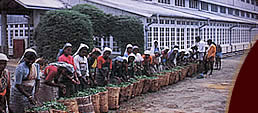 |
| |
The tea factories found on most tea estates
play a vital role in the final value of the manufactured
tea. Regardless of how carefully the leaf has been grown
and plucked, if the processes at the factory are not carried
out properly the end result will be of a poor quality.
A tea factory is a multi-storeyed building, almost always
sited on the tea estates to ensure that the time between
plucking and processing tea is kept to a minimum. Once
the tea leaves arrive at the factory they are spread across
the upper floors of the building in troughs – a
process known as withering. Withering removes all excess
moisture in the leaf to make it pliable.
Once the tea leaves have been withered, they are rolled,
twisted and broken up. This acts as a catalyst for the
enzymes in the leaves to react; this chemical reaction
occurs when the leaf comes in contact with air, which
is necessary for the production of black tea. The leaves
are rolled on circular tables, which are fitted with brass
or wooden battens. The leaf is fed in from above through
an open cylinder and as this cylinder rotates the amount
of pressure applied to the leaf against the table surface
is adjusted.
The leaf particles are collected after rolling and are
spread out on a table where they start to ferment when
exposed to warm air. The fermentation time is dictated
by the prevailing weather pattern. This brings about the
changes necessary to make the tea liquor palatable. As
this chemical process of oxidisation takes place the colour
of the leaf changes from a green to a bright coppery colour.
The fermented leaf is then put into a firing chamber where
the hot air prevents any further chemical reaction from
taking place. The temperature at which the tea has been
fired will determine the keeping qualities of the tea.
Once the firing process is completed the leaves emerge
hard and black, and are ready for grading.
Grading determines the value of the final product. The
tea particles are separated into different shapes and
sizes by sifting them through a progressively finer series
of meshes. The various grades of tea denote only the size
and appearance of the leaf and bear no relation to quality.
The graded teas are finally weighed and packed into tea
chests or paper sacks and dispatched to the tea brokering
companies. |
| |
|
| |
Top
of the page |



